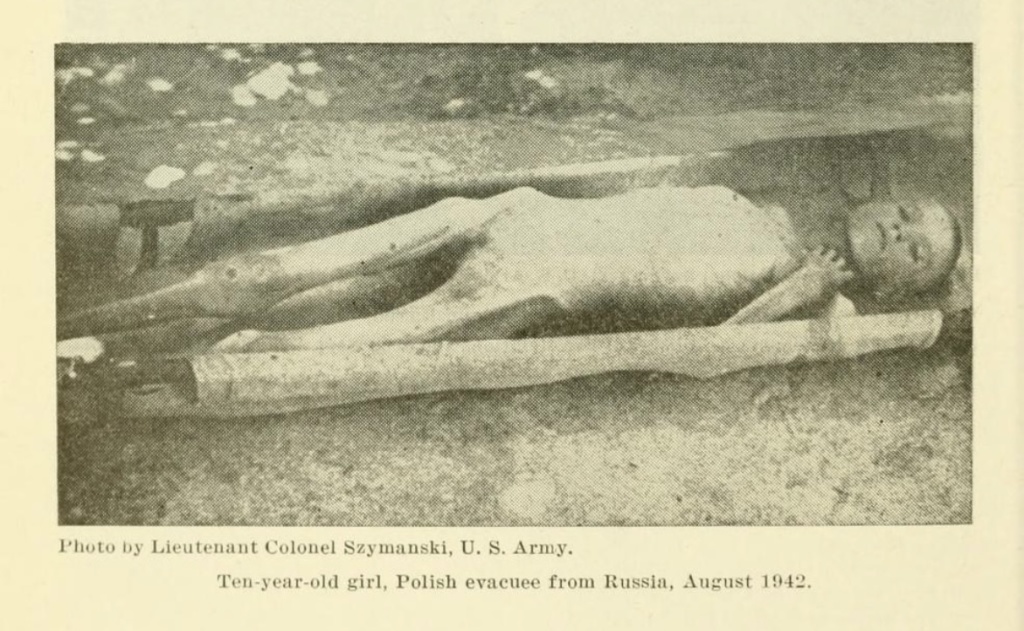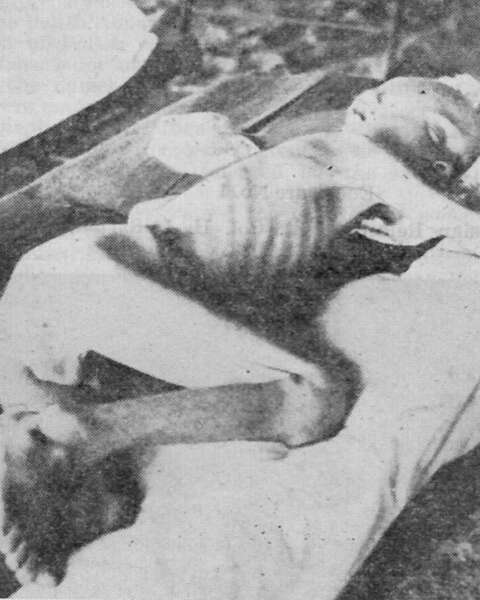U.S. Government Propaganda Photo
This U.S. Government propaganda photo showing an unidentified Polish woman with two children at a refugee camp in Iran was taken by the Office of War Information (OWI) photographer in Iran in 1943. By that time, this woman was safe and both of her children looked healthy and no longer starved. For several months with thousands of other Polish refugees she had been in Iran under the care of Polish, American and British authorities and private relief organizations, providing them with food and medical care. But before that, hundreds of thousands of Polish women, children and men had spent hellish years in Soviet Russia as slave laborers forcefully deported from their homes in eastern Poland. We don’t know whether the healthy-looking Polish woman shown in the U.S. government propaganda photo was married, and, if she had a husband, whether he might have been executed or died in the Soviet Union. We don’t know if she had any children and whether any of them had lived. We also don’t know what she had to do in Russia to survive.
Very few Americans and other Westerners knew this story then, and very few know it even today. To protect Stalin and the anti-Germany military alliance with Moscow, pro-Soviet propagandists in President Franklin D. Roosevelt’s administration did not publish photos of Polish men, women and children who were starved, ill and near death when they were evacuated from Soviet Russia to Iran in 1942. They did not tell the real stories of these refugees. On the contrary, they did everything possible to prevent Americans and the rest of the world, including listeners to Voice of America (VOA) radio broadcasts, from getting the true story of Polish refugees evacuated from Russia. The evacuees were even told by the Polish government-in-exile not to discuss what had happened to them in the Soviet Union. Stalin was still holding hundreds of thousands of Polish citizens as hostages, and the Polish government-in-exile was still trying to reach an accommodation with Moscow. The Poles were under strong pressure from Washington and London to appease Stalin who, however, had completely different plans for Poland and the rest of East Central Europe.
Naive U.S. propagandists said nothing about what might have happened to Polish women in Soviet captivity. Many had lost their husbands, children and close family members in Russia. Whole families, both the youngest and oldest members, were deported under brutal conditions from their homes in eastern Poland which had been occupied in 1939 by the Red Army under the secret terms of the Hitler-Stalin Pact. U.S. propagandists were instead promoting an image of Stalin as a radical democrat and a guarantor of peace and security.
Lieutenant Colonel Henry I. Szymanski was a U.S. Army Liaison Officer to the Polish Army created under the command of General Władysław Anders during the Second World War II which fought the Germans alongside American and British troops in North Africa and Italy. On November 22, 1942, Lt. Col. Szymanski sent a report on Polish-Russian relations to the Military Intelligence Division, War Department General Staff (G-2), in Washington, DC.
In August 1942, he saw and took photos of many starved and dying Polish refugees, including children, who had been evacuated with the Anders Army from Soviet Russia to Iran. In his lengthy report, which was classified as secret and not published until 1952, he made several observations about Polish women slave laborers who had managed to escape from the Soviet Union.
Ten-year-old girl, Polish evacuee from Russia, August 1942. Photo by Lieutenant Colonel Henry I. Szymanski, U.S. Army, taken in Iran and published in 1952 by the bipartisan Select Committee to Conduct an Investigation of the Facts, Evidence and Circumstances of the Katyn Forest Massacre, Eighty-Second Congress, also known as the Madden Committee after its chairman, Rep. Ray Madden (D-IN).
6. …it appears that the plan was very carefully worked out, and its purpose was the extermination of the so-called intelligentsia of Eastern Poland.
…Families were broken up and in many cases the husband shot..1
8. The deportees were assigned work in coal and iron mines, on the laying of roads and railroads, on irrigation projects, in forests, on construction of building, on farms. No discrimination was shown between men and women. A woman had to cut and pile as much wood as a man, she had to carry 15 lbs. of bricks or mortar, she had to excavate 9 1/2 cubic meters twice-shifted despite the fact that the normal excavation was 6 cubic meters. … if anyone fell below the quota, he or she, was docked and consequently could not buy enough bread.2
11. Women not accustomed to hard manual labor and consequently not able to earn enough for their daily bread had a choice of starving to death or submitting to the Bolshevik or Mongol supervisor. In one sense their condition was bettered–they had something to eat. When asked by me whether they worked hard, a reluctant answer of, “I wanted to live,” would be given [to] me. The Polish military medical authorities are taking blood tests to determine the number of generals among women. The tests were not completed prior to my departure, but the results will be handed [to] me.3
- Source: The Katyn Forest Massacre: Hearings Before The Select Committee to Conduct An Investigation on The Facts, Evidence and Circumstances of the Katyn Forest Massacre; Eighty-Second Congress, Second Session On Investigation of The Murder of Thousands of Polish Officers in The Katyn Forest Near Smolensk, Russia; Part 3 (Chicago, Ill.); March 13 and 14, 1952 (Washington: United States Government Printing Office, 1952), pp. 455.
To protect Stalin and the anti-Germany military alliance with Moscow, pro-Soviet propagandists in President Franklin D. Roosevelt’s administration did not publish photos of Polish children who were starved, ill and near death when they were evacuated from Soviet Russia to Iran in 1942. Likewise, OWI’s Voice of America radio broadcasts did not mention Soviet executions of Polish prisoners of war and mistreatment of Polish deportees, including women and children, in the Soviet Gulag camps and collective farms, to which they had been sent as slave laborers. VOA’s radio broadcasts for foreign audiences and a broadcast by OWI Director Elmer Davis targeting Americans also spread Soviet propaganda lies about the mass executions of Polish prisoners in Soviet Russia known collectively as the Katyń Forest massacre. Americans and foreigners alike were misled by Roosevelt administration’s propaganda about the true nature of Stalin and the Soviet regime — a point highlighted in bipartisan criticism after the war.
The bipartisan Madden Committee of the House of Representatives blamed it in 1952 on “a strange psychosis that military necessity required the sacrifice of loyal allies and our own principles in order to keep Soviet Russia from making a separate peace with the Nazis.” The committee pointed out that “this psychosis continued even after the conclusion of the war.” In a warning about a corrupting effect of foreign and domestic propaganda combined with censorship, the Madden Committee noted that “most of the witnesses testified that had they known then what they now know about Soviet Russia, they probably would not have pursued the course they did.”
The 1948 Smith-Mundt Act passed by the U.S. Congress significantly restricted use of tax dollars to target Americans with news and political commentary produced by the U.S. government. Some of these restrictions were later lifted. The Smith-Mundt Modernization Act of 2012, which was contained within the National Defense Authorization Act for Fiscal Year 2013 (section 1078 (a)) and signed by President Obama, amended the 1948 Smith-Mundt Act and subsequent legislation, allowing for materials produced by the State Department and the Broadcasting Board of Governors (BBG), which included the Voice America, to be made more easily available within the United States.
U.S. Government institutions responsible for false propaganda about Polish and other deportees in the Soviet Union, the Katyń lie, and misleading information about wartime refugees from Russia never admitted that they had done anything wrong and have insisted through even the most recent statements of their officials that the Voice of America was created during the Second World War to broadcast only truthful news.
Radio Free Europe, also funded by U.S. tax dollars, however, never lied about Katyń or censored information about the plight of Polish and other prisoners in the Soviet Gulag.
During most of the Cold War, especially in later years, VOA Polish Service broadcasters also played a positive role of bringing uncensored news and offering moral support to the victims of communism.
U.S. Government Propaganda Photo

- Title: Teheran, Iran. Baby girl at a Polish evacuee camp with her mother
- Creator(s): Parrino, Nick, photographer, Office of War Information (OWI)
- Date Created/Published: 1943.
- Repository: Library of Congress Prints and Photographs Division Washington, D.C. 20540 USA
- LINK
Photos by Lt. Col. Henry I. Szymanski, U.S. Army
- Twelve-year-old boy, Polish evacuee from Russia, August 1942
- Six-year-old boy, Polish evacuee from Russia, August 1942
- Three sisters, ages 7, 8, and 9, Polish evacuees from Russia, August 1942
- Photos by: Lieutenant Colonel Henry I. Szymanski, U.S. Army
- Source: The Katyn Forest Massacre: Hearings Before The Select Committee to Conduct An Investigation on The Facts, Evidence and Circumstances of the Katyn Forest Massacre; Eighty-Second Congress, Second Session On Investigation of The Murder of Thousands of Polish Officers in The Katyn Forest Near Smolensk, Russia; Part 3 (Chicago, Ill.); March 13 and 14, 1952 (Washington: United States Government Printing Office, 1952), pp. 459-461.
- Link
Notes
- Eighty-Second Congress, Second Session On Investigation of The Murder of Thousands of Polish Officers in The Katyn Forest Near Smolensk, Russia; Part 3 (Chicago, Ill.), March 13 and 14, 1952, The Katyn Forest Massacre: Hearings Before The Select Committee to Conduct An Investigation on The Facts, Evidence and Circumstances of the Katyn Forest Massacre (Washington: United States Government Printing Office, 1952), 455.
- Eighty-Second Congress, The Katyn Forest Massacre: Hearings Before The Select Committee to Conduct An Investigation on The Facts, Evidence and Circumstances of the Katyn Forest Massacre, 455.
- Eighty-Second Congress, The Katyn Forest Massacre: Hearings Before The Select Committee to Conduct An Investigation on The Facts, Evidence and Circumstances of the Katyn Forest Massacre, 455.






Voice of America – USAGM Management Censored News to Protect Communist Vietnam — Radio Free Asia Did Not
November 20, 2022